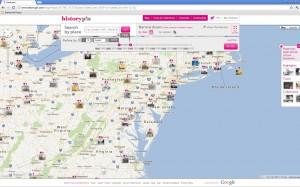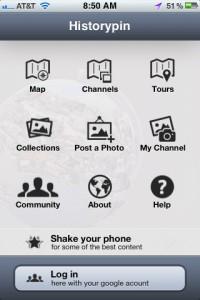We are surrounded by historic buildings and structures. We work in them, shop in them, and eat in them. With Historypin, you can now know your everyday buildings' histories, and be part of their documentation. Historypin is a user-generated global archive of photographs taken in the past and present. The goal of the Historypin project, created by WeAreWhatWeDo, is to connect groups of people within a community and bridge age gaps through a shared history.
This summer, I selected more than 250 images from the Hagley Digital Archive to add to Historypin. In the selection process, I first focused on images from the Gentieu Collection of Brandywine River Valley Images, choosing images from 1880-1920 taken by photographer and former DuPont Company employee Pierre Gentieu.
I was interested in forming a snapshot of what it would have been like to work in the DuPont Company black powder yards in the late 1800s, and I particularly wanted to find photos of the structures that no longer stand. But photographs of structures on the grounds did not tell the full story, so I expanded my search beyond the Gentieu Collection to include churches, schools, taverns, shops, and even other nearby mills and industries. This gave me a fuller understanding of the community of workers on the Brandywine in northern Delaware at the height of the American Industrial Revolution.

The main feature of Historypin is the map. Photographs are pinned to the map using the latitudinal and longitudinal coordinates of the location they were taken. The map shows the location of the photographs in time, so it is possible to narrow down the years of the photographs visible on the map using a timeline slider. Some photographs that were taken from the street can be overlaid on Google street view.
Since most of the photographs are on the Hagley Museum grounds, I was only able to do a street view overlay for 17 of the images. Here are a few examples: Alexis I. DuPont School, Wilmington Train Station, Washington Avenue and Concord Street Solgas Truck Accident, and Rockland Bridge.
Another important part of Historypin is the story behind the photograph. I did a lot of my research in the Hagley Digital Archives, pulling stories from the photograph descriptions and captions written by the photographer. I also gathered stories by going outside (I am a big proponent of experiencing history outdoors). I had taken a tour of Hagley before, but with the historic photographs in mind, I looked at the grounds with new interest, walking every inch of the property I could access.
I drove downstream from Hagley to see for myself Breck's Mill, Walker's Mill, and the former covered bridge at Rising Sun Lane (I even got one of my carpool buddies to jump out of the car and take a photograph of the plaque on the new steel bridge). As I gathered more stories, I found that the stories for other photographs changed with the new perspective I gained. And by venturing outdoors to find the history, I was able to easier pin the photographs on the map in an area that is entirely tree-covered from an aerial view today (but was not when the DuPont Company black powder mills were running).
After pinning the photographs to the map with their stories, I dove into the other features of Historypin: collections and tours. I made two collections: one called The Industrial Brandywine in Delaware, and another titled On the Grounds of the Hagley Museum and Library. Having taken Hagley's Powder Yard Trail self-guided tour, which is written in walking order for guests, I wanted to create a tour on Historypin that explained black powder-making in the order of the process.
There are many excellent channels on Historypin from which to pull inspiration. There are channels by institutions, such as the Smithsonian, and by individuals, such as Steve Clifford. Some channels have appealing designs, such as Bath in Time. To get ideas about what types of tours you can create with your own photographs, check out these tours: Washington Slept Here from the Connecticut State Library, The 1968 Democratic National Convention that includes a sound file from the U.S. National Archives, Lost Louisville from University of Louisville Photographic Archives, and Earthquake and Fire from San Francisco MTA Archives.
To think about collections in a non-traditional way, check out the Women in the Military collection from the U.S. National Archives, or The Snow Collection created by Historypin using photos from many different channels. If you are interested in doing a local project and getting your community involved, take a look at Reading's History local project, or if you just want to get involved as an individual, consider taking a modern photograph, or a repeat such as this one of a photograph from San Francisco MTA Archives.
 Historypin is not only a website, but an App for mobile devices, so it is easy to get involved.
Historypin is not only a website, but an App for mobile devices, so it is easy to get involved.
With the App, you can explore pins near you, post your own photos, and explore other collections.
The Hagley Museum and Library Historypin channel will continue to be added to; I have only created a launching pad for the project. I encourage visitors of the museum and people in the Wilmington area to get involved, too: take a tour, take a modern replica of a photograph, or create your own channel and post your own photos of the Brandywine area.
Della Hall, University of Delaware
